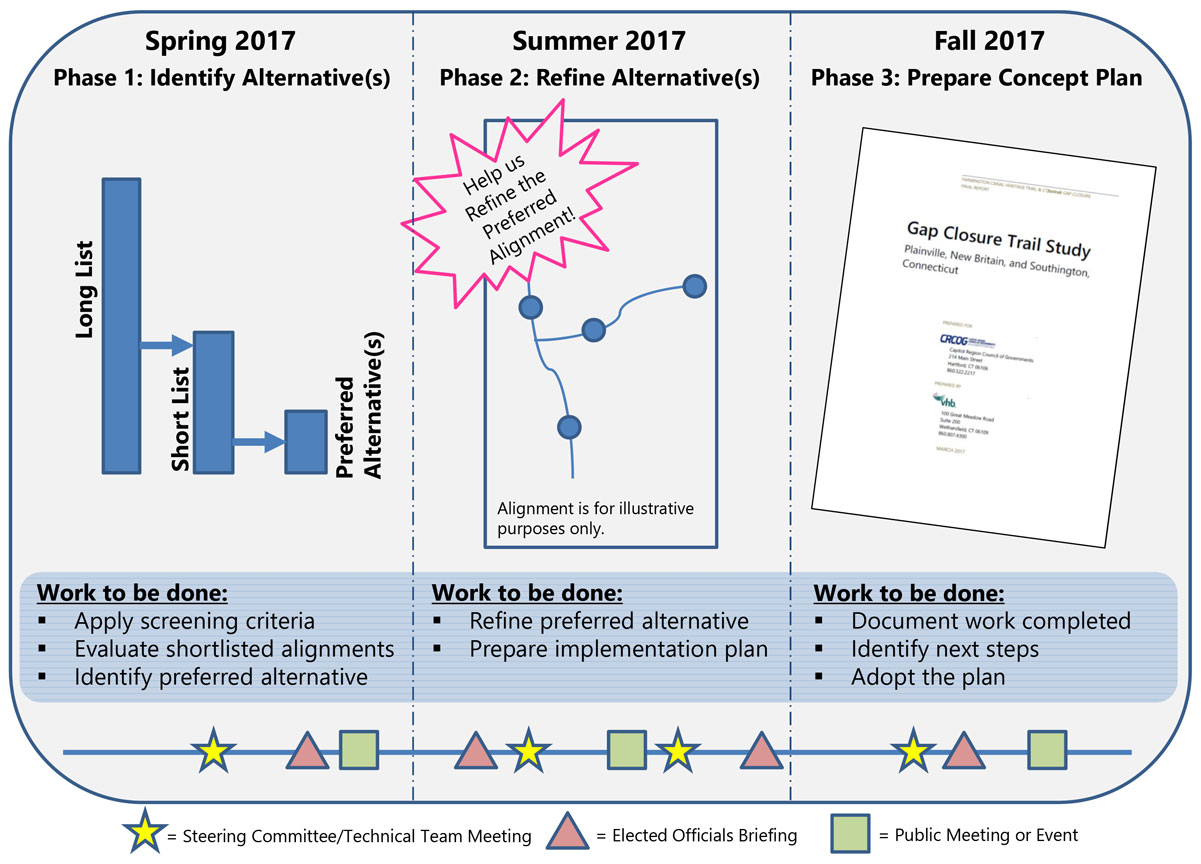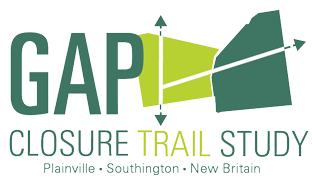Frequently Asked Questions
You will find answers below to common questions about the study. Please submit your question(s) via the form on this page.
Q1 - Who is CRCOG and what are they doing?
The Capitol Region Council of Governments (CRCOG) is a regional planning agency guided by the chief elected officials of 38 Metro Hartford municipalities (as of July 1, 2014). The mayors, first selectmen, and town council chairmen who make up our governing Policy Board recognize that the future of our individual members is tied to the future of our region. Our members have collaborated for more than 30 years on a wide range of projects to benefit our towns individually and the region as a whole. The full development of the Farmington Canal Heritage Trail has been a regional planning goal/initiative for many years. CRCOG initiated this study in order to thoughtfully engage the communities in determining the best possible alignment in order to "Close the Gaps" in our regional trail system.
Q2 - Why has the development of the Farmington Canal Heritage Trail through Plainville taken so long?
The Farmington Canal Heritage Trail is an 84 mile rail trail, the majority of which, is on a publically owned rail corridor. The portion of the rail corridor through Plainville is privately owned and actively supports freight operations. In addition to a lack of public right-of-way, the Town has numerous physical constraints including Interstate 84, active railroads running north/south & east/west, numerous State Highways (10, 372, 72, 177, 532 536) and two major rivers (Quinnipiac and Pequabuck). The Town is also has areas of dense development increasing the complexity of routing a trail through Town.
Q3 - Why do we need the Farmington Canal Heritage Trail?
The Farmington Canal Heritage Trail provides many health, environmental, economic and tourism benefits for our communities. Existing sections of the trail have proven to be immensely popular to residents and tourists alike.
Q4 - Where will the trail go, specifically?
We don't know! Please send us your suggestions, or better yet, attend one of our many public meetings or events!
Q5 - How are you going to get property owners to agree to this?
At this stage in the trail development process, a study is being conducted to identify a possible route that the community supports. Currently, design and/or construction funding has not been secured. We anticipate that there may be concerns about property and will take those into consideration throughout the process. If you have any specific concerns about crime, real estate values, privacy, liability or others please attend one of the meetings or send us your comments, we would love to hear from you.
Q6 - How much will it cost and where will the money come from?
There are a number of Federal and State sources of funding for trails; we hope to create a compelling story to win access to funds for design and construction in the future.
Q7 - The Farmington Canal Heritage Trail runs North/south, why is this study looking at an East/West connection to New Britain?
The desire to connect a major regional trail system (the FCHT) to the southernmost station in the State's bus rapid transit system has been a goal of State, Regional and local planners for years.
The connection to New Britain is an important one because for the first time, it would allow residents an option other than riding a bus or driving a vehicle to access the CTfastrak Station and the existing multi-use trail to Newington Junction or commute to Hartford or other stops along the CTfastrak route.
Q8 - What is CTfastrak?
CTfastrak is Connecticut's first bus rapid transit (BRT) system. BRT is an innovative, high capacity, cost-effective public transit solution that can significantly improve travel times through heavily-congested areas by using dedicated transit guideways or lanes to avoid traffic and quickly transport passengers to their destinations. By operating in a permanent, dedicated bus-only guideway, while allowing buses to enter and depart the line, the CTfastrak system offers the speed of a rail system with the flexibility of bus service to meet transit demand and provide passengers convenient point-to-point service to their destinations. Learn more here.
Q9 - Has a final decision been made regarding where the trail will go?
While the study has made a lot of progress, no final decisions have been made and we still have a lot of work to do. We are in the process of refining our preliminary preferred alignment to try to work out the details of the alignment. We are also identifying any potential "tricky spots" for further review and exploring ways to address comments and concerns expressed by the public, town staff, and other stakeholders. We will be reviewing the results of our evaluation as well as presenting our preferred alignment at a public workshop in September, where we hope to get more input on the alignment. After that, we’ll take any feedback we get and further refine the preferred alignment and start working on an implementation plan. We’ll present the draft plan at a public meeting and seek feedback from the community. After that, we’ll present our recommendations to the Town Council in Plainville and the Common Council in New Britain for their review. Then it will be up to each community to decide if, how, and when to move the projects forward.
Q10 - What is the project schedule?

